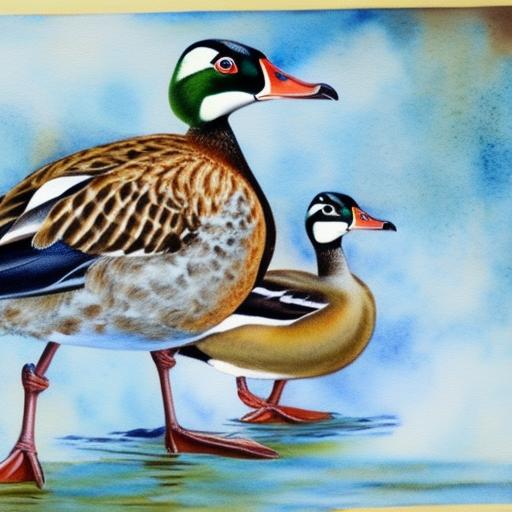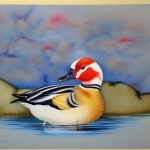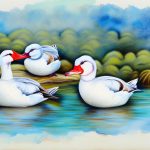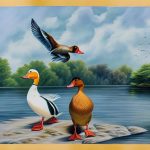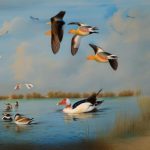The Australian Wood Duck, also known as Maned Duck, is a species of dabbling duck found throughout Australia and New Zealand. These ducks are easily recognizable by their striking appearance, with a combination of dark and light colors on their feathers. They are medium-sized ducks with a distinctive mane of feathers on their heads, which sets them apart from other duck species. Australian Wood Ducks are commonly found in a variety of habitats, including wetlands, marshes, and grasslands, where they feed on a diet of grasses, seeds, and insects. These ducks are known for their strong pair bonds and are often seen in pairs or small family groups.
Australian Wood Ducks are highly adaptable and can be found in both urban and rural areas, making them a familiar sight to many Australians. They are known for their distinctive call, which is a loud, high-pitched whistle that can be heard from a distance. These ducks are also known for their graceful flight, with their long necks outstretched and their distinctive white wing patches visible in flight. Overall, Australian Wood Ducks are a beloved and iconic species in Australia, and their presence adds to the natural beauty of the country’s landscapes.
Key Takeaways
- Australian Wood Ducks are a common species found throughout Australia, known for their distinctive appearance and behavior.
- These ducks are known for their strong monogamous bonds and their preference for nesting in tree hollows or man-made structures.
- Australian Wood Ducks breed during the spring and summer months, with females laying a clutch of eggs in their chosen nesting site.
- Factors such as habitat loss, predation, and human disturbance can impact the breeding success of Australian Wood Ducks.
- Conservation efforts, such as protecting nesting sites and managing predator populations, are crucial for ensuring the survival of Australian Wood Ducks during breeding season.
Behavior and Characteristics of Australian Wood Ducks
Australian Wood Ducks are known for their unique behaviors and characteristics that set them apart from other duck species. These ducks are primarily herbivorous, feeding on a diet of grasses, seeds, and other plant matter. They are often seen foraging in grassy areas or grazing on the edges of wetlands and water bodies. Australian Wood Ducks are also known for their strong pair bonds, with males and females forming monogamous pairs that can last for multiple breeding seasons. These pairs are often seen flying and foraging together, and they work together to defend their territory and raise their young.
In addition to their distinctive appearance and behavior, Australian Wood Ducks are also known for their vocalizations. They have a loud, high-pitched whistle that is used for communication between individuals and pairs. This call is often heard during the breeding season as the ducks establish and defend their territories. Australian Wood Ducks are also known for their graceful flight, with their long necks outstretched and their distinctive white wing patches visible in flight. Overall, the behavior and characteristics of Australian Wood Ducks make them a fascinating species to observe and study.
Nesting and Breeding Habits of Australian Wood Ducks
Australian Wood Ducks have specific nesting and breeding habits that are essential to the survival of their species. These ducks typically breed in the spring and summer months when food sources are abundant, and conditions are favorable for raising young. They prefer to nest in tree hollows or nest boxes near water bodies, where they can find protection from predators and easy access to food. The female wood duck will lay a clutch of eggs, usually between 9-11 eggs, and she will incubate them for around 30 days before they hatch.
Once the ducklings hatch, they are precocial, meaning they are born with their eyes open and are able to leave the nest shortly after hatching. The parents will lead the ducklings to water where they can learn to swim and find food. The ducklings will stay with their parents for several months until they are fully independent. During this time, the parents will fiercely defend their young from predators and other threats. Overall, the nesting and breeding habits of Australian Wood Ducks are crucial to the survival of their species, and they play a vital role in maintaining healthy populations.
Factors Affecting Breeding Success in Australian Wood Ducks
Several factors can affect the breeding success of Australian Wood Ducks, including habitat loss, predation, and human disturbance. Habitat loss is a significant threat to wood ducks, as it reduces the availability of suitable nesting sites and food sources. Wetland drainage, urban development, and agricultural expansion all contribute to habitat loss for wood ducks, making it more challenging for them to find suitable breeding grounds.
Predation is another significant factor affecting breeding success in wood ducks. Nest predators such as foxes, raccoons, and snakes can pose a threat to wood duck eggs and ducklings. Additionally, human disturbance can disrupt wood duck breeding behaviors and cause stress to nesting pairs, leading to decreased breeding success. Activities such as boating, fishing, and recreational use of wetlands can disturb wood ducks and cause them to abandon their nests or young.
Conservation efforts aimed at addressing these factors are crucial for ensuring the breeding success of Australian Wood Ducks. Protecting and restoring wetland habitats, implementing predator control measures, and minimizing human disturbance in breeding areas are all essential strategies for supporting healthy wood duck populations.
Conservation Efforts for Australian Wood Ducks during Breeding Season
Conservation efforts for Australian Wood Ducks during breeding season are essential for ensuring the survival of this iconic species. One of the most critical conservation measures is the protection and restoration of wetland habitats where wood ducks breed. Wetlands provide essential nesting sites and food sources for wood ducks, making them crucial for supporting healthy populations. Conservation organizations work to protect wetlands from development, pollution, and other threats to ensure they remain suitable for wood duck breeding.
Another important conservation effort is predator control to reduce the impact of nest predators on wood duck breeding success. This may involve trapping or removing predators from wood duck nesting areas to minimize predation on eggs and ducklings. Additionally, efforts to minimize human disturbance in wood duck breeding areas are essential for supporting successful breeding behaviors. This may involve implementing regulations or guidelines for recreational activities near wetlands during the breeding season.
Overall, conservation efforts for Australian Wood Ducks during breeding season play a vital role in ensuring the long-term survival of this species. By protecting their habitats, minimizing predation, and reducing human disturbance, conservationists can help support healthy wood duck populations for future generations.
Tips for Birdwatchers and Wildlife Enthusiasts during Australian Wood Duck Breeding Season
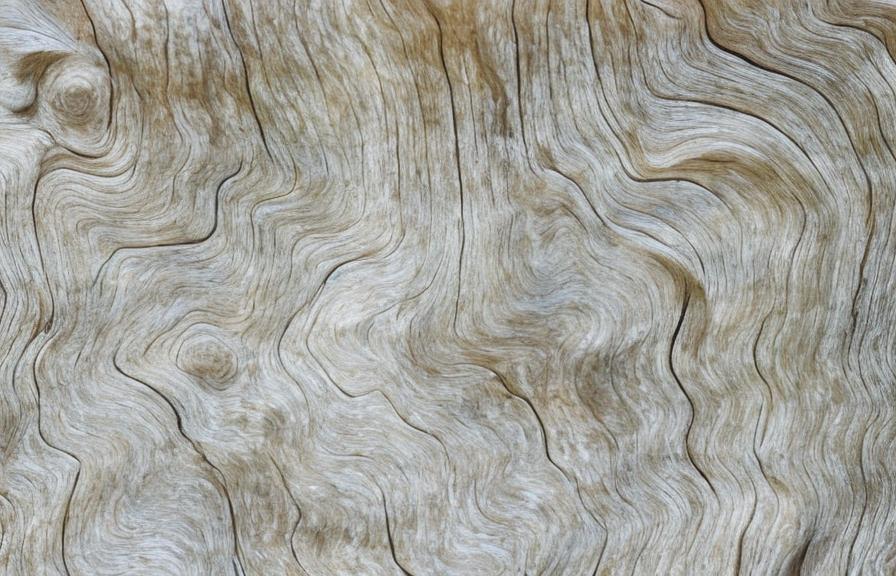
For birdwatchers and wildlife enthusiasts interested in observing Australian Wood Ducks during breeding season, there are several tips to keep in mind to minimize disturbance to these birds while enjoying their natural behaviors. First and foremost, it’s essential to respect any posted signs or regulations regarding access to wood duck breeding areas. These signs may indicate restricted areas or guidelines for minimizing disturbance to nesting pairs and young ducklings.
When observing wood ducks, it’s important to maintain a respectful distance from nesting sites and avoid approaching or disturbing nesting pairs or young ducklings. Using binoculars or spotting scopes can allow birdwatchers to observe wood ducks from a distance without causing stress or disruption to the birds. Additionally, avoiding loud noises or sudden movements near wood duck breeding areas can help minimize disturbance to these birds during this critical time.
Finally, supporting conservation efforts for Australian Wood Ducks by volunteering with local organizations or donating to conservation initiatives can help ensure the long-term survival of this species during breeding season and beyond. By following these tips and guidelines, birdwatchers and wildlife enthusiasts can enjoy observing Australian Wood Ducks while minimizing their impact on these birds during this important time in their lifecycle.
The Importance of Protecting Australian Wood Ducks during Breeding Season
In conclusion, Australian Wood Ducks play a vital role in Australia’s ecosystems, and protecting them during breeding season is essential for ensuring their long-term survival. By understanding the behavior and characteristics of wood ducks, as well as the factors affecting their breeding success, conservation efforts can be targeted towards addressing these challenges. Protecting wetland habitats, implementing predator control measures, and minimizing human disturbance in wood duck breeding areas are all crucial strategies for supporting healthy wood duck populations.
Conservation efforts for Australian Wood Ducks during breeding season not only benefit this iconic species but also contribute to the overall health of wetland ecosystems in Australia. By following tips for observing wood ducks respectfully during breeding season and supporting conservation initiatives, birdwatchers and wildlife enthusiasts can play a role in protecting these birds for future generations to enjoy. Ultimately, the importance of protecting Australian Wood Ducks during breeding season cannot be overstated, as they are an integral part of Australia’s natural heritage that deserves our attention and conservation efforts.
As the Australian wood duck breeding season approaches, it’s essential to ensure that these beautiful birds are well-nourished. In a recent article on PoultryWizard, the importance of providing the right diet for ducks is highlighted. The article, “What Should You Feed Ducks?,” offers valuable insights into the nutritional needs of ducks, which can be particularly beneficial during their breeding season. By understanding the dietary requirements of ducks, including the Australian wood duck, breeders can help support their health and reproductive success.
FAQs
What is the breeding season for Australian wood ducks?
The breeding season for Australian wood ducks typically occurs from August to December.
Where do Australian wood ducks build their nests?
Australian wood ducks build their nests in tree hollows, logs, or other suitable cavities, often near water.
How many eggs do Australian wood ducks typically lay?
Australian wood ducks typically lay a clutch of 9-11 eggs, although this number can vary.
How long does it take for Australian wood duck eggs to hatch?
It takes approximately 28-30 days for Australian wood duck eggs to hatch.
Do Australian wood ducks mate for life?
Australian wood ducks are known to form long-term pair bonds, and in some cases, they may mate for life.
What do Australian wood ducks feed their young?
Australian wood ducks feed their young a diet of insects, grasses, and other vegetation found in their environment.
Are Australian wood ducks protected during the breeding season?
Australian wood ducks are protected under various conservation laws and regulations, and it is important to respect their breeding habitats and nesting sites during the breeding season.
Meet Walter, the feathered-friend fanatic of Florida! Nestled in the sunshine state, Walter struts through life with his feathered companions, clucking his way to happiness. With a coop that’s fancier than a five-star hotel, he’s the Don Juan of the chicken world. When he’s not teaching his hens to do the cha-cha, you’ll find him in a heated debate with his prized rooster, Sir Clucks-a-Lot. Walter’s poultry passion is no yolk; he’s the sunny-side-up guy you never knew you needed in your flock of friends!

